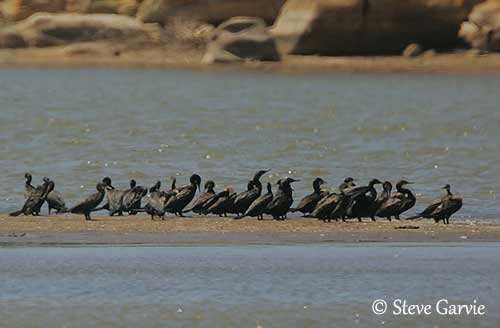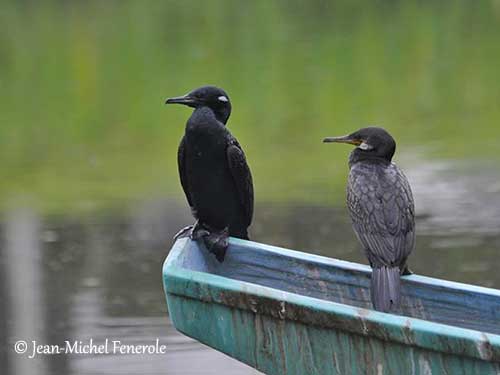
Fr: Cormoran à cou brun
Ang: Indian Cormorant - Indian Shag
All: Braunwangenscharbe
Esp: Cormorán Indio
Ita: Cormorano indiano
Nd: Indische Aalscholver
Sd: indisk skarv
Photographers:
John Anderson
John Anderson Photo Galleries
Didier Buysse
Vision d’Oiseaux
Jean Michel Fenerole
Photos d’Oiseaux du monde
Steve Garvie
RAINBIRDER Photo galleries & Flickr Rainbirder
Text by Nicole Bouglouan
Sources:
HANDBOOK OF THE BIRDS OF THE WORLD vol 1 by Josep del Hoyo-Andrew Elliot-Jordi Sargatal - Lynx Edicions - ISBN: 8487334105
BIRD COUNT INDIA - Cormorants Clarified
Wikipedia, the free encyclopaedia
Page family Phalacrocoracidae
Summary cards
Indian Cormorant or Indian Shag
Phalacrocorax fuscicollis
Suliformes Order – Phalacrocoracidae Family
INTRODUCTION:
The Indian Cormorant or Indian Shag is a member of the family Phalacrocoracidae. It is mainly present along the inland waters of the Indian Subcontinent, but it also occurs W to Pakistan, S in Sri Lanka, E to Thailand, Cambodia and Vietnam.
It frequents freshwater and marine habitats, but it avoids open coasts. It typically feeds on fish caught by pursuit-diving.
The species is sedentary. It breeds in mixed-species colonies. The stick nest is built in tree over water.
The Indian Cormorant is affected by habitat degradation and human disturbance in the breeding areas, but currently, the species is not globally threatened.

DESCRIPTION OF THE BIRD:
Biometrics:
Length: 63 cm
Weight: 600-790 g
The Indian Cormorant in breeding plumage has mostly black head, neck and body plumage with blue-green gloss, although mantle, scapulars and upperwing-coverts are mainly bronze-brown with fringed black feathers.
The breeding adult shows conspicuous, contrasting white tufts on each side of the upper neck.
On the head, the bare facial skin and the gular pouch are sooty-black or dark brownish-olive during the breeding season.
The long, slender bill is blackish-grey with hooked tip. The eyes are green. Legs and webbed feet are blackish-grey.
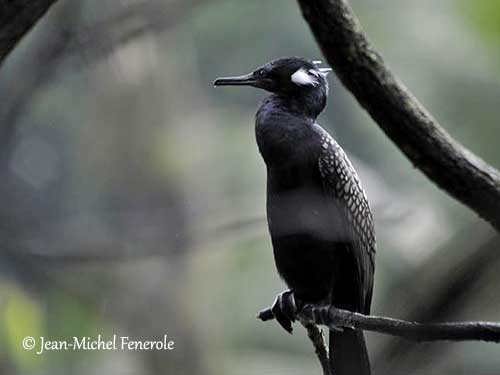
In non-breeding plumage, the adult is duller with less contrasting upperpart’s pattern. It may show some white on throat to gape. The lower ridge of mandible and the gular pouch become dull yellowish.
Male and female are similar.
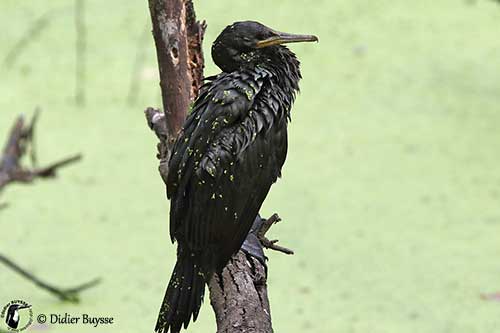
The juvenile is mainly dark brown or blackish-brown, with dense pattern from mantle to upperwing-coverts. There is sometimes a variable whitish area on the throat, and pale brownish streaking from lower foreneck to central breast.
On the head, the bare skin from gape to gular pouch is yellowish. The eyes are duller than in adults.
The immature is fairly similar but with dark streaking and more patterned upperparts. The belly is largely white with variable blackish-brown blotches. The eyes are already green.
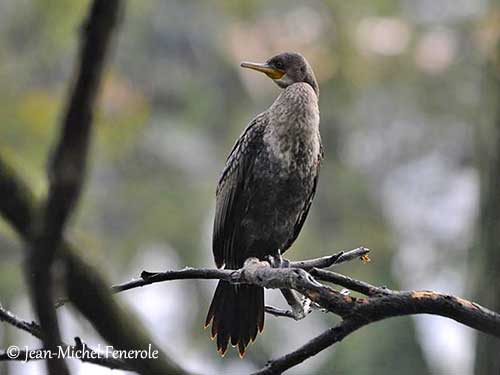
RANGE:
The Indian Cormorant is found along the inland waters of Indian Subcontinent, extending W to Pakistan and S to Sri Lanka, and then E to Bangladesh, Myanmar, Thailand, Cambodia and Vietnam.
HABITAT:
The Indian Cormorant can be seen fishing in inland rivers and large wetlands, both in freshwater and marine habitats, lakes, tidal estuaries and mangroves, but it does not occur on the open coast.
In the Himalayas, it can be found in the foothills, but not beyond.
CALLS AND SONGS: SOUNDS BY XENO-CANTO
The Indian Cormorant is usually silent outside of breeding season. It becomes more vocal at colonies where it gives short, harsh notes described as “grk” or “kit”. These notes are given in accelerating series.
BEHAVIOUR IN THE WILD:
The Indian Cormorant feeds mainly on fish. To catch a prey, it dives into the water and pursues the fish underwater. The prey is caught with the bill. During the pursuit, the bird propels itself by using its webbed feet like oars. Once the fish is caught, the bird returns to the surface. The prey is thrown into the air to return it, before to swallow it head first.
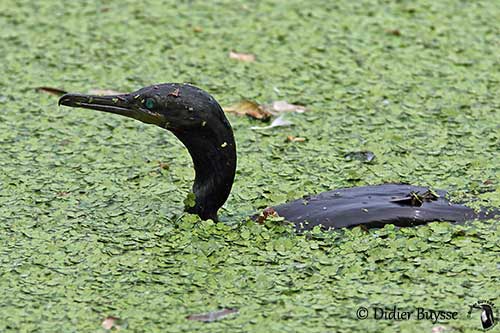
The Indian Cormorant is known to fish in groups. The birds gather in a large water area and round up prey items. They may form a broad front to drive fish into a corner, making them easier to catch.
The Indian Cormorant breeds in mixed-species colonies and the nest is built in tree over the water.
The courtship displays of this species are not described, but the typical displays usually involve “wing-waving” while the bill is pointed upwards and forwards, and the “gargling display” during which the male throws the head back until the nape touches the rump. The bill is wide open while the bird produces a special call. During the displays, the white tufts of the upper neck are exposed.
The Indian Cormorant is sedentary and only performs some short movements related to water conditions and food abundance.
The flight is usually powerful with fairly regular wingbeats interspersed with occasional glides.
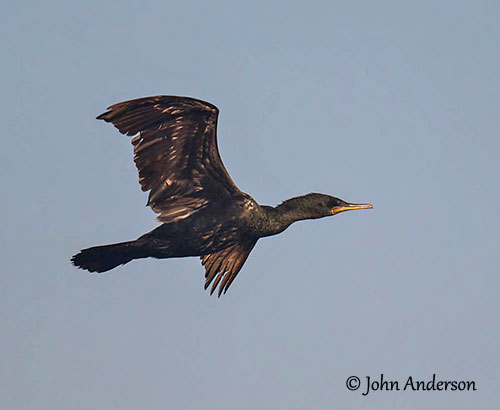
REPRODUCTION OF THIS SPECIES:
The breeding season takes place from July to February in N India and from November to February in the southern part. This period varies depending on the region and water conditions.
The Indian Cormorant breeds in dense colonies with other cormorants, but also darters, herons, egrets, storks, ibises and spoonbills. The nest, made with sticks and stems, is lined with softer material. It is built in tree fork, sometimes in half submerged trees, and over water.
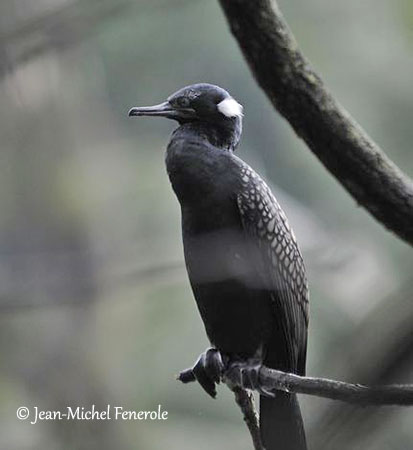
The female lays 3-5 bluish-green eggs with chalky surface. The duration of the incubation is unknown, but it probably lasts about 30 days. At hatching, the chicks are naked, but they have soon a brownish-black down.
PROTECTION / THREATS / STATUS:
The Indian Cormorant is affected by degradation of the habitat, human disturbance around the colonies and drying up of water bodies.
The population was estimated to number 30,000 individuals in 2006.
The species is not considered globally threatened and the Indian Cormorant is currently evaluated as Least Concern.
